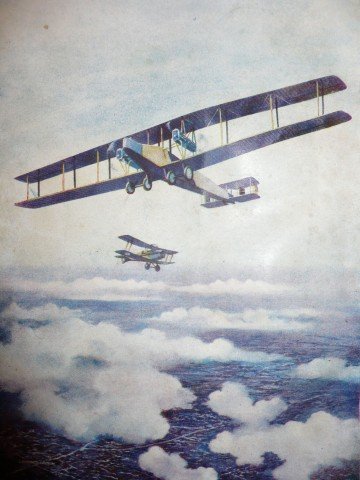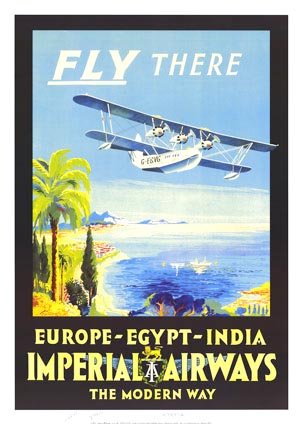
A GIANT OF THE AIR. A HANDLEY-PAGE FOUR-ENGINED BIPLANE.
A Handley Page V/1500, the Kabul bomber. Below is (I think) a S.E.5a.
Image source: Harry Golding, ed., The Wonder Book of Aircraft for Boys and Girls (London: Ward, Lock & Co, 1919), frontispiece. Painting by Geoffrey Watson.
![]() This work is licensed under a Creative Commons Attribution-NonCommercial-NoDerivatives 4.0 International License.
Permissions beyond the scope of this license may be available at http://airminded.org/copyright/.
This work is licensed under a Creative Commons Attribution-NonCommercial-NoDerivatives 4.0 International License.
Permissions beyond the scope of this license may be available at http://airminded.org/copyright/.




I feel a bit stupid asking this, but I only see two engines. The wingspan on that thing looks immense, though: just by eye it looks about three times a normal biplane’s span.
The engines are back to back; each nacelle has two engines and two props, one pusher and one tractor.
Aha, thanks. That’s a pretty wild design: were there any other prop planes with engines in parallel?
Heaps … arguably the best being the Dornier Do335
http://www.youtube.com/watch?v=CReTXZwIsEw
Cool video! I’ve never seen one in flight before.
If you click on the picture for the hi-res version, you can make out the engines a bit better. A comparable push-pull configuration from that period would be the German R.VI, which was used to bomb London.
And you’re right, Jonathan, about the wingspan: it’s huge. The V/1500 was 38 metres (126 feet) from wingtip to wingtip — compare with a B-17 at 31 metres. At 42 metres the R.VI’s wingspan was even bigger, only about a metre shorter than the B-29’s!
Yeah, once Jakob mentioned it, I did see it. the Dornier video is fascinating: unless I’m mistaken the front engine is actually turned off briefly in flight about halfway through the video.
Was this a short-lived innovation that got outstripped by jets, or was there some other reason I’ve never, ever heard of the push-pull configurations before?
It wasn’t used all that often. Wikipedia has a very brief page about push-pull aircraft, which mentions some of the advantages relative to a conventional multi-engine configuration: minimising drag is the main one (which would be one reason why it was used for the Do 335 fighter). Also, as you note, it can fly with only one engine — that’s generally true of a twin-engine aircraft, but in this case there’s no yaw (from the remaining engine pulling to one side, though there’d still be torque from the propeller rotation to deal with — no idea how significant that is, not being a pilot or aerospace engineer!)
Certainly once jets came along there was little incentive to push piston-engine aircraft to their limits, but as the V/1500 shows, push-pull was in use long before jets came along (with partial exceptions!) I’m not sure why the V/1500 was designed this way — I doubt anybody cared about drag, given all the struts and wires and wings. Maybe the reduced yaw was a consideration, though with four engines in a (now-)conventional configuration, there wouldn’t have been much yaw if one failed anyway. Maybe they weren’t confident that the wings would support two engines further out? That the R.VI used push-pull for a comparable aircraft and role suggests that there was some reason for it …
Checking out the cool 335 footage, I’ve just had one of those blinding flashes of inspiration that might be misleading. Unlike in previous wars, this kind of secret weapon home movie was available to the leadership. If Goering and Hitler were watching this kind of thing every evening, it must have helped them to retreat to their fantasy world in which the wonder-weapons would save them at the last minute – to the detriment of actually maintaining the air force that they had.
Or perhaps not.
Off the top of my head: For fabric-covered structures like the V/1500 I would imagine that wing strength was a big driver in putting the engines inboard. As for wider push-pull configurations, the rear prop is a fair bit less efficient (it’s in all the dirty air coming off the front), and cooling might be an issue. If you’re putting the engines in the wing the bulbous nacelles might not give you a drag benefit.
Push-pull designs configurations were quite popular for flying boats, as you can mount the engines above the wing out of the way of any spray thrown up; in fact most of Dornier’s boats seem to have used this setup.
Most of the key points re. the 335 are coming out above. Dornier had experience in this design. Drag and manoeuvrability are key issues – Germany needed (heavily armed, long duration) Zerstorers to deal with the Allied bombers but conventional twins were slain by single engine/seater fighters primarily o/a (lack of) speed and manoeuvrability. Is this mainly to do with rotation around the axis? The only workable solutions were (armoured) Sturm 190s and (fast, therefore gone) 262s. The 335 could have helped being fast, heavily armed and long duration. And yes, there were rear engine cooling problems ~ overcome by increasing drag (cooling intakes etc.).
Another key point (a long way off the orginal topic but nevertheless follows) is the issue of scaling up production when under consistent attack. It was all Germany could do to keep making stuff from late ’43. Getting a new front-line aircraft operational (with all the issues of development, retooling and operational support) is a major diversion. Reflect on the continuance of the 109 and 110 in the face of the far superior 262 and 219. All these late war wonders were too late – the die had been cast by ’43.
Thanks, Jakob and Don, for some informed comment. I was think that lack of torque on the Do 335 (because the two propellers would cancel each other out) might be a useful advantage in terms of throwing the aircraft around the sky …
Germany did manage to make quite a lot of stuff after 1943, particularly fighters — more than 7000 Fw 190s, nearly 13000 Me 109s. The trouble was fuel and (I think) pilots to fly them. At least the Do 335 had the advantage over the Me 262, from a production/maintenance/training viewpoint, of conventional engines and relatively low fuel consumption. It might have been easier to deploy clouds of Do 335s than Me 262s late in the war. Not that it would have made much difference, as Don says.
I like Chris’s suggestion about the dangers of letting dictators watch film of advanced prototypes. On the other hand, I wonder if even a more realistic grasp of Germany’s military resources would have induced Hitler to surrender … probably not.
Coming at this over a decade later(!?!) I note Jakob’s comment regarding the engine location vs wing strength. It’s a point, but comes far behind wanting the engines as close to the centreline as you can to avoid adverse yaw in the case of engine failure, or any differential engine power settings. That’s why most piston multi-engine types have the engines as close in as technically viable (prop swept areas etc) then as now. There’s also the question of mass location in terms of the manoeuvrability and balance of the airframe (not the same as the strength, though related) in that you don’t want heavy engines a long way out as the roll and yaw control will become very nasty. So push-pull nacelles have good advantages. There were the Dorniers flying boats – Wal and Do 18 (and Do 26, a beautiful design) for starters, the Farman F.222 and many others that used them, though rare in the grand scheme of aviation development.
What was REALLY unusual – and tried – was locating the engine in the centre, INSIDE the fuselage with some kind of drive to external props – used on a couple of German bomber Great War types (Lloyd 40.06, Siemens-Schuckert R.VIII) and inter war experimentals too (the Boulton & Paul P.12 Bodmin for one). And a couple of brothers around 1903 tried that as well, but forgot to add a fuselage.
(We think that wooden biplanes were not strong – but they were. A biplane, properly rigged is basically a classic beam structure and for the structural weight, remarkably load bearing – like a bridge.)
When pull-push is discussed, I immediately think of the Cessna Skymaster, which was manufactured with a conventional piston engine in the front and a rotary (Wankel type) engine in the rear of the fuselage, between twin tail booms. (A few have been converted to other configurations – including a flying car!)
With its central thrust axis, it allows a pilot with a single-engine license to fly a very fast multi-engine plane, which in turn allows for operations over seas and other expanses that are otherwise out of reach. It was used in the war in Viet Nam for search, forward air control, and propaganda missions.
(I see now that I erred. Operating the Skymaster requires at least a centerline thrust multi-engine rating, if not a conventional one.)
Not sure where you got the Wankel rotary from – the Cessna 337 Skymasters are normally powered by two conventional Continental IO-360 engines. Not a new configuration of course (See Dornier Do 335, itself following the pre-war Do 18) though the Cessna is probably the largest, successful production run in this layout.
JDK and Chas C-Q:
Thanks, both. One of the pleasures of running a blog over 14 years is having old posts and discussions resurface from time to (sometimes very long) time!